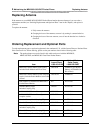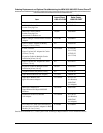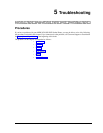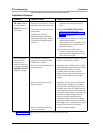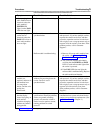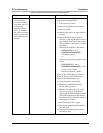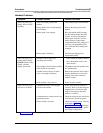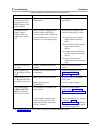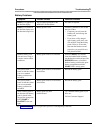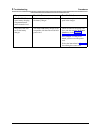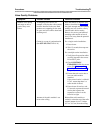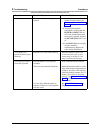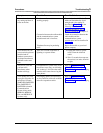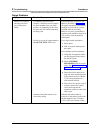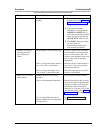
5 Troubleshooting Procedures
MDW 9031/9031DCP Wireless Pocket Phone Installation and Use
503-801-166108 Issue 3 October 1999
You can hear the party
on the other end, but
they cannot hear you.
MUTE appears in the
handset display.
M button was pressed
inadvertently.
Press M again to turn off the
mute feature.
When placed in the
battery charger’s
handset cradle, the
handset does not turn
off.
Battery charger is plugged into an
electrical outlet controlled by a
switch, and the switch is turned off.
Battery charger’s power cord is not
inserted or is not inserted properly.
Plug the battery charger into an
outlet not controlled by a switch.
1 Unplug the power cord/AC
adapter from the electrical
outlet.
2 Disconnect the power cord/AC
adapter from the battery
charger.
3 Carefully reconnect the power
cord/AC adapter to the battery
charger.
4 Plug the power cord/AC
adapter back into the electrical
outlet.
Handset does not ring
or vibrate.
Alerter is disabled and vibrator is
disabled.
Enable the alerter and/or the
vibrator.
After you press O
or ", display does not
light.
Handset must be programmed for
backlighting.
Enable the backlighting. (See
“Enabling or Disabling
Backlighting” in Chapter 3.)
After you press O
or ", the handset does
not wake up or turn on.
Battery pack may not be charged.
Battery pack may have
malfunctioned.
If you have one, try a different
battery pack.
Call for Customer Support.*
Your handset shows
CHANGE BUTTN
MAP in the display
when you try to use it.
Your handset is not mapped to the
correct switch.
If your handset is mapped to the
correct switch, but you are still
getting the message, your station
wiring is incorrect.
Change the handset button
mapping. (See “Changing the
Communications System Setting”
in Chapter 2.)
Check your station wiring, referring
to the table in “Radio
Module/Switch Wiring” in Chapter
2 and your switch manual’s station
port wiring configuration.
* See “Customer Support” in the Copyright and Legal Notices at the beginning of this book
Symptom Possible Causes Possible Solutions



